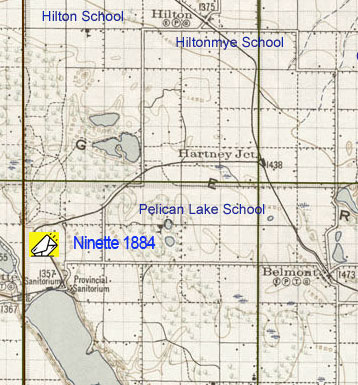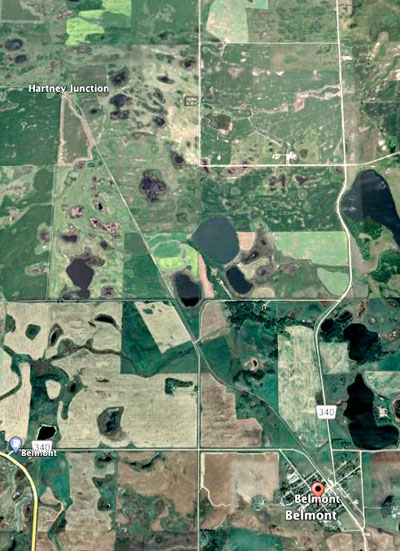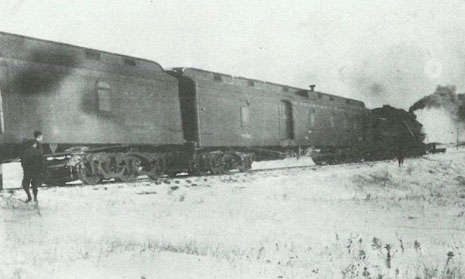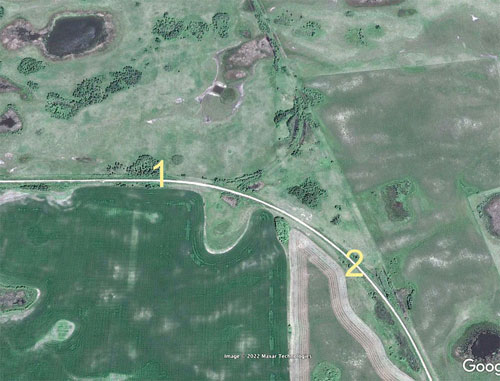 |



CN train at Hartney Junction


Photo 1

Photo 2
Excerpts from Local Histories
When the Hartney Branch line was completed in 1898 Belmont became a railroad town and a divisional point: a pumping station, coal dock, round houś and "Y" were built, and the Company employed 23 men earning a total monthly payroll of $1,500.
In 1898 the Northern Pacific and the Manitoba Railway built a rail line from Hartney Junction through Ninette to Hartney and it was then possible to travel from Belmont to Hartney. The train on this line was nicknamed "The Can- nonball". Belmont also became a junction point in 1898 and was the junction of the Belmont Virden extension of the Canadian National Rail- way. The railway offered free return trips to \Winnipeg to celebrate the event. For many years there was a return daily service both on the Bran- don-rWawanesa-Hilton-Belmont-Baldur line and on the Hartney-Ninette-Belmont line.
Ashford and Thordis (Chadwick) (6-5-15)had one daughter, Alice born in 1911. She recalls a story her mother told: About the year 1909, her father and mother walked to the Hartney Junction, west of their farm to catch the 10:15 a.m. train to Belmont. They had lunch at the Trafalgar Hotel, shopped and caught the 4 o'clock train back home.
1943 the community numbered only 75 people and in 1975 this had decliíred to 15.
n 1898 the Northern Pacif ic and Man itoba Railway built a line from Hartney Junction, through Ninette to Hartney. lt was now possible to travel by rail from Belmont to Hartney and this cut off Hilton's trade from the south and business slumped.
The year the steel was laid on the C.N.R. from the Hartney Junction, I was engaged to take a load of lumber from Charley Brown's lumber yard at Hilton to be used in the building of Mr Yellowlees' store at Ninette. The trail ran close to some sloughs that were impossible to evade. I got stuck with the load several times and had to take off the boom and carry the bulk of the load to more solid ground through the mud and water. It was late afternoon when I arrived at the track, about where the Sanitorium is now. The track laying machine was busy laying the ties and rails. I stopped there to feed my horses. I was feeling famished myślf but when I went to get my dinner pail I discovered that it had been left at one of the places where I got stuck. The track crew had laid a temporary suritch to one side where the cook car set. I had a little money on me so I went to the cook and related my plight, asking if I could get something to eat, and I would pay for it. He said, I was quite welcome if I would just wait until he heated up the beef soup. When I got a whiff of that delicious smelling beef soup the zuspense tortured me. The cook was quite a liberal gentleman and gave me several helpings of this soup. I enjoyed every spoonful of it. When I was through, I offered to pay him but he refused to accept anything and asked if I would go out by the South door as the wind was blowing from the North and would cause dust to blow in over the tables. I made my exit at the opposite side of the car to where I came in. I saw something hanging by a hook, high up on the side of the car, in the sun. It was a big piece of beef and was badly flyblown. However I had enjoyed my soup and was thankful. It made my thoughts turn to the old saying, 'What the eyes don't see the heart won't grieve. "
